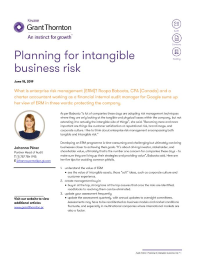-
Financial statements audits
Financial statement audits
-
Compliance audits
Compliance audits
-
Compilations and reviews
Compilations and audit
-
Agreed-upon procedures
Agreed-upon procedures
-
Corporate and business tax
Our trusted teams can prepare corporate tax files and ruling requests, support you with deferrals, accounting procedures and legitimate tax benefits.
-
International tax
Our teams have in-depth knowledge of the relationship between domestic and international tax laws.
-
Tax compliance
Business Tax
-
Individual taxes
Individual taxes
-
Estate and succession planning
Estate and succession planning
-
Global mobility services
Through our global organisation of member firms, we support both companies and individuals, providing insightful solutions to minimise the tax burden for both parties.
-
Sales and use tax and indirect taxes
SUT/ VAT & indirect taxes
-
Tax incentives program
Tax incentives program
-
Transfer Pricing Study
The laws surrounding transfer pricing are becoming ever more complex, as tax affairs of multinational companies are facing scrutiny from media, regulators and the public
-
Business consulting
Our business consulting services can help you improve your operational performance and productivity, adding value throughout your growth life cycle.
-
Forensic and investigative services
At Grant Thornton, we have a wealth of knowledge in forensic services and can support you with issues such as dispute resolution, fraud and insurance claims.
-
Fraud and investigations
The commercial landscape is changing fast. An ever more regulated environment means organizations today must adopt stringent governance and compliance processes. As business has become global, organizations need to adapt to deal with multi-jurisdictional investigations, litigation, and dispute resolution, address the threat of cyber-attack and at the same time protect the organization’s value.
-
Dispute resolutions
Our independent experts are experienced in advising on civil and criminal matters involving contract breaches, partnership disputes, auditor negligence, shareholder disputes and company valuations, disputes for corporates, the public sector and individuals. We act in all forms of dispute resolution, including litigation, arbitration, and mediation.
-
Business risk services
We can help you identify, understand and manage potential risks to safeguard your business and comply with regulatory requirements.
-
Internal audit
We work with our clients to assess their corporate level risk, identify areas of greatest risk and develop appropriate work plans and audit programs to mitigate these risks.
-
Service organization reports
As a service organization, you know how important it is to produce a report for your customers and their auditors that instills confidence and enhances their trust in your services. Grant Thornton Advisory professionals can help you determine which report(s) will satisfy your customers’ needs and provide relevant information to your customers and customers’ auditors that will be a business benefit to you.
-
Transaction advisory services
Transactions are significant events in the life of a business – a successful deal that can have a lasting impact on the future shape of the organizations involved. Because the stakes are high for both buyers and sellers, experience, determination and pragmatism are required to bring deals safely through to conclusion.
-
Mergers and acquisitions
Globalization and company growth ambitions are driving an increase in M&A activity worldwide as businesses look to establish a footprint in countries beyond their own. Even within their own regions, many businesses feel the pressure to acquire in order to establish a strategic presence in new markets, such as those being created by rapid technological innovation.
-
Valuations
We can support you throughout the transaction process – helping achieve the best possible outcome at the point of the transaction and in the longer term.
-
Recovery and reorganization
We provide a wide range of services to recovery and reorganisation professionals, companies and their stakeholders.
5 tips to manage enterprise risk in businesses driven by innovation
What is enterprise risk management (ERM)? Roopa Baboota, CPA (Canada) and a charter accountant working as a financial internal audit manager for Google sums up her view of ERM in three words: protecting the company.
As per Baboota “a lot of companies these days are adopting risk management techniques where they are only looking at the tangible and physical losses within the company, but not extending it to actually the intangible side of things”, she said. “Becoming more and more important are things like customer satisfaction or reputational risk, brand image, and corporate culture. I like to think about enterprise risk management encompassing both tangible and intangible risk.”
Developing an ERM programme is time-consuming and challenging but ultimately can bring businesses closer to achieving their goals. “It’s about driving investor, stakeholder, and shareholder value, ultimately that is the number one concern for companies these days – to make sure they are living up their strategies and providing value”, Baboota said. Here are her five tips for avoiding common pitfalls.
- understand the value of ERM
- see the value of intangible assets, those “soft” ideas, such as corporate culture and customer experience.
- create management buy-in
- buy-in at the top, strong tone at the top assures that once the risks are identified, roadblocks to resolving them can be eliminated.
- update your assessment frequently
- update the assessment quarterly, with annual updates to oversight committees. Assessments may have to be recalibrated as business models and market conditions fluctuate, and especially in multinational companies where international markets are also a factor.
- ensure roles are clearly define
- management remains responsible for risk, and this should be documented in the internal audit charter. Internal audit department can act as a consultant to help management assess risk and develop a process and audit plan or act from an assurance perspective. However, internal audit should not be managing risk on behalf of management.
- research to stay ahead of the game
- stay up to date with current events, read more and be aware of how it can affect your organization.
Remember that once you keep apprised of what’s going on in the world the answers will come, influenced by your experience. “If you have a risk mindset, you’ll naturally be able to anticipate things.”
Source:
Planning for intangible business risks. A Google auditor offers 5 tips to manage enterprise risks in businesses driven by innovation. By Samiha Khanna. FM Magazine, June 2018
We are committed to keep you updated of all developments that may affect the way you do business in Puerto Rico. Please contact us for further assistance in relation to this or any other matter.


